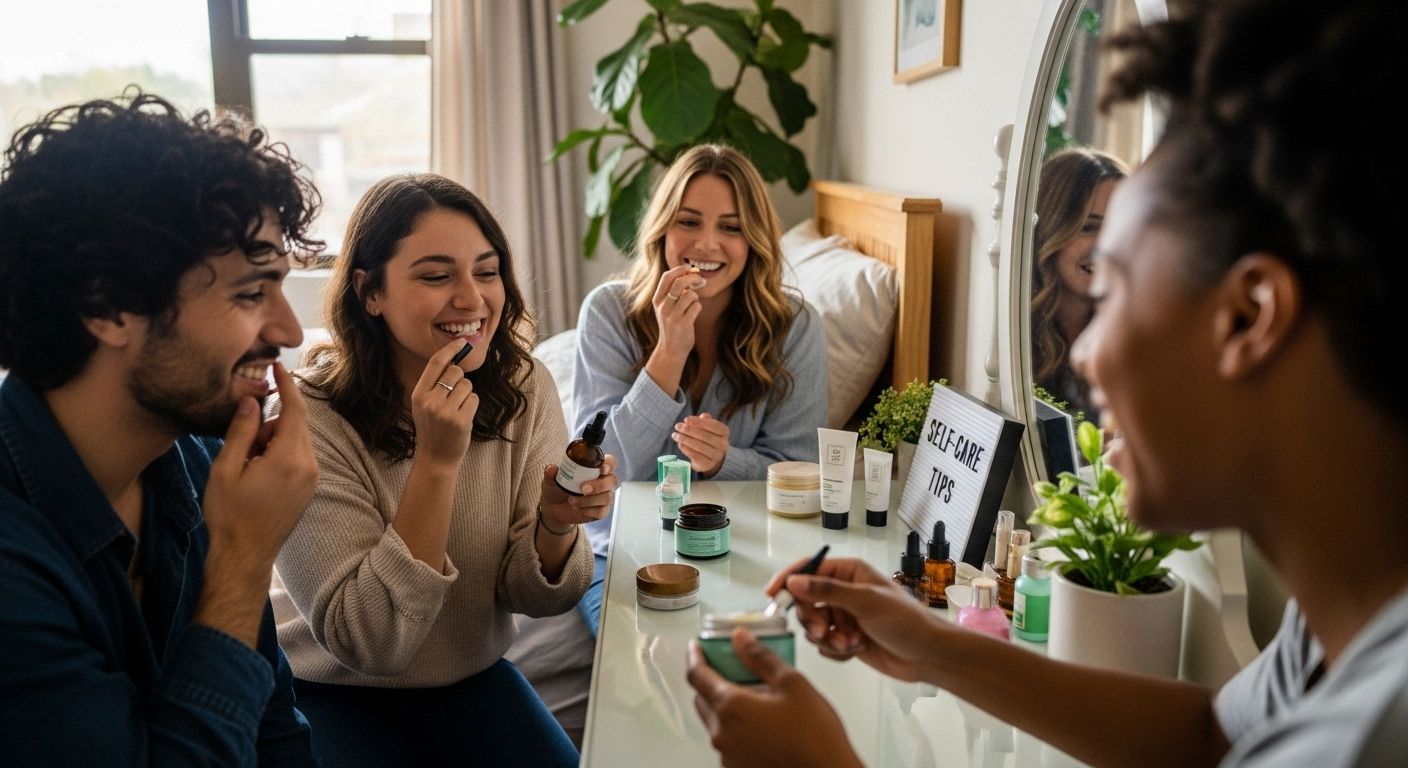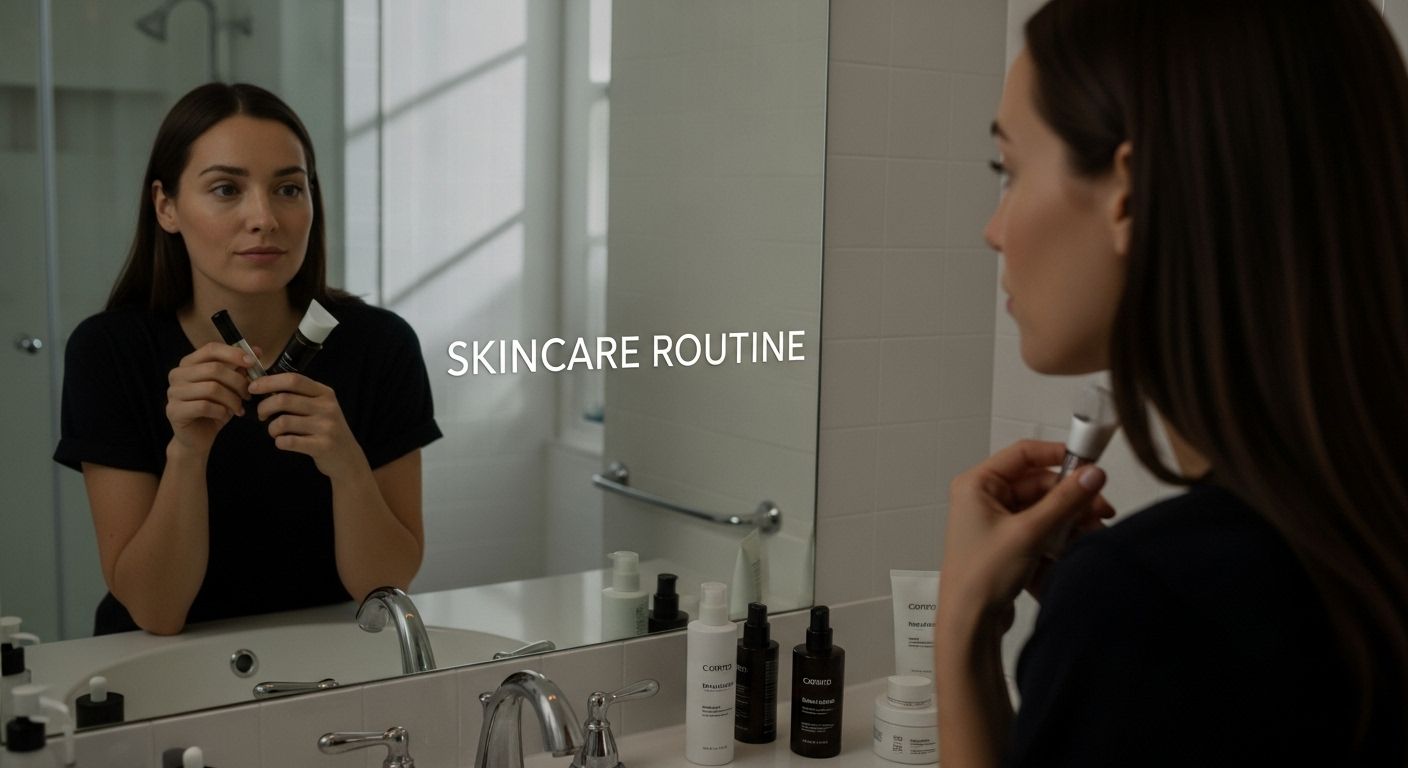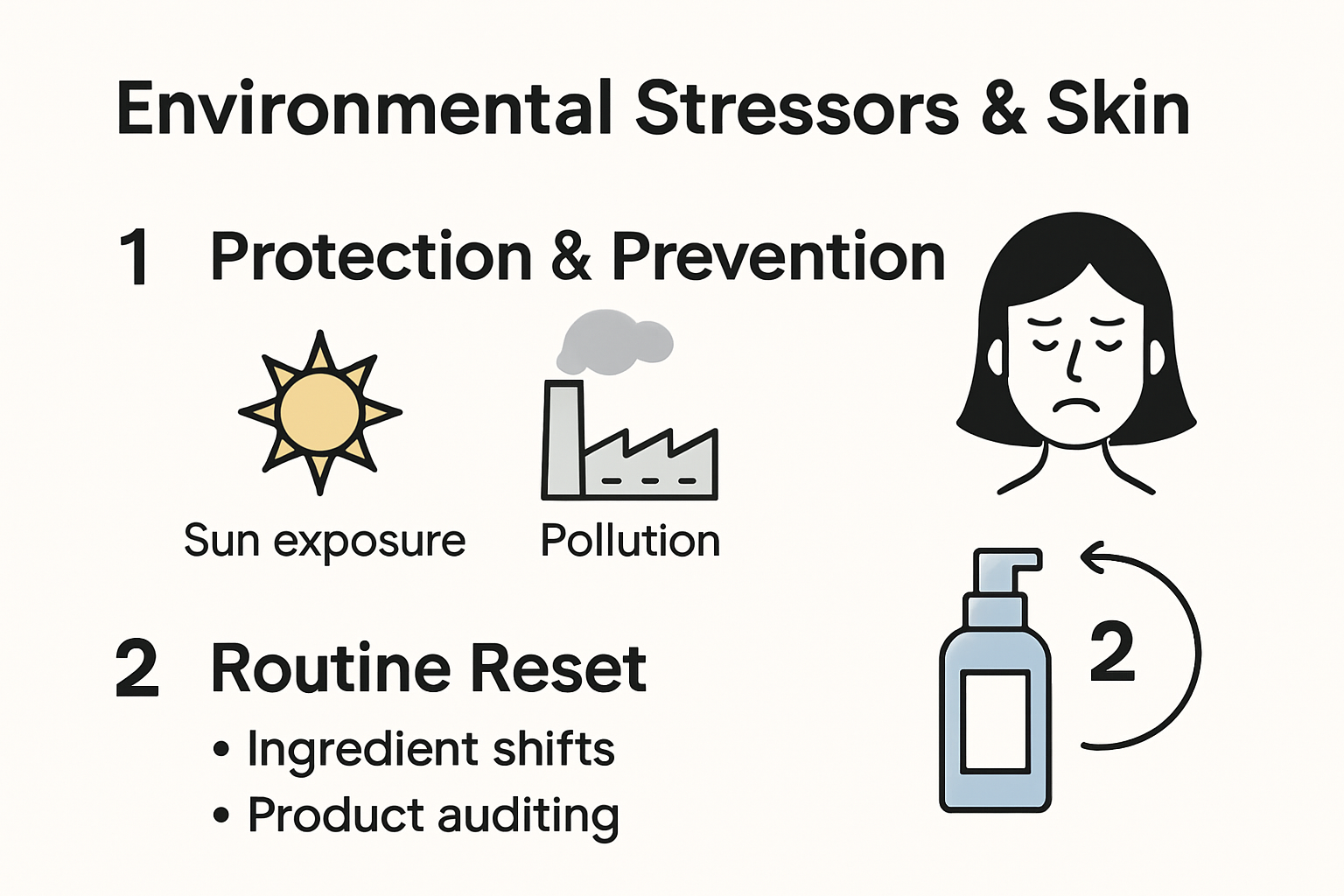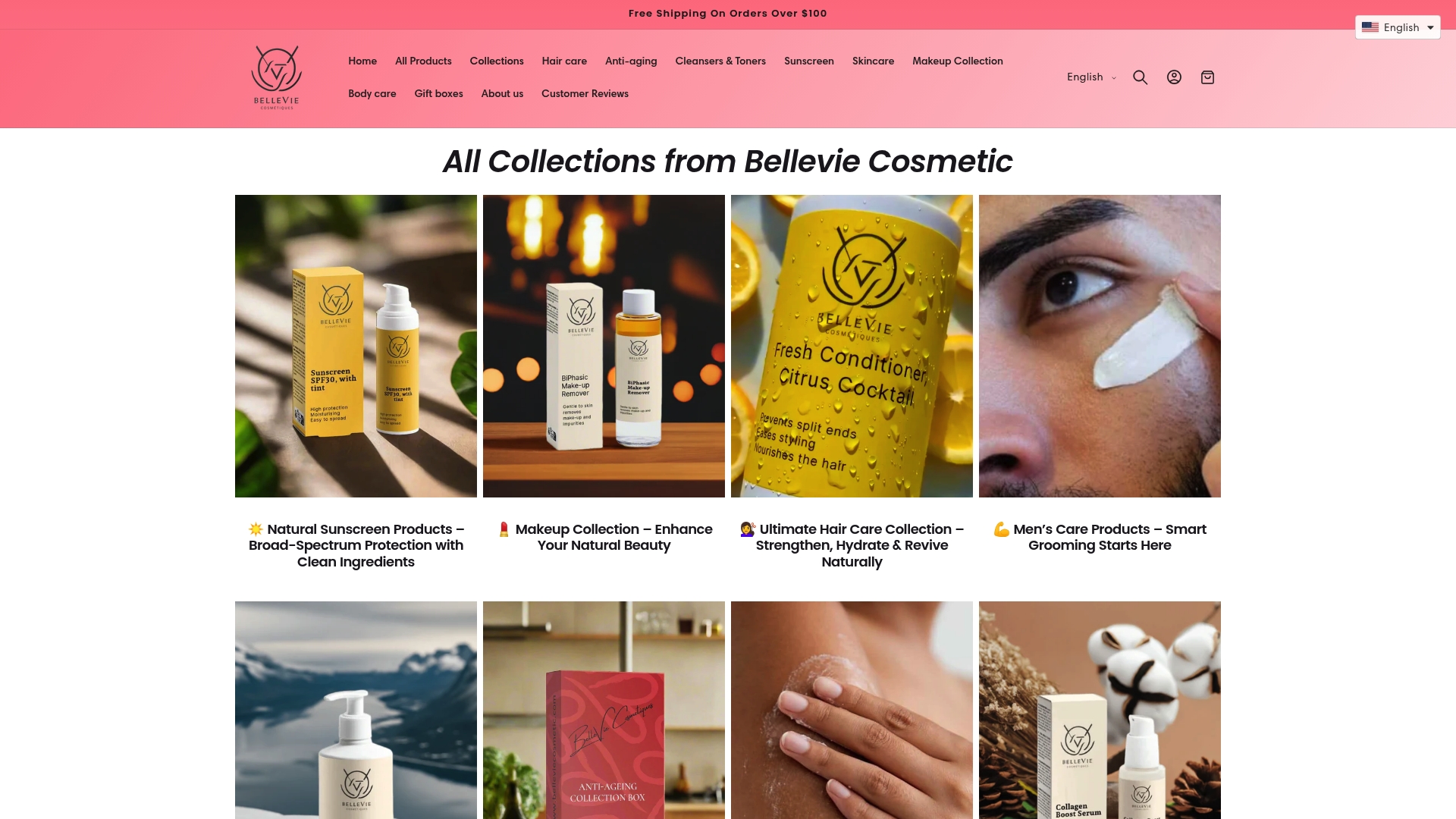Skincare routines are getting a major reset in 2025 and experts say your old products might be working against you. Most people cling to the same steps for years but studies show that 70 percent of those who changed their skincare routine noticed big improvements in their skin. You might think sticking to what you know brings the best results but it turns out real progress comes from knowing exactly when to shake things up.
Table of Contents
- Why Resetting Your Skincare Routine Matters
- Step-by-Step Guide for a Skin Reset
- Choosing Clean, Anti-Aging Essentials
- Eco-Friendly and Self-Care Skincare Tips
Quick Summary
| Takeaway | Explanation |
|---|---|
| Regularly reset your skincare routine. | Your skin’s needs evolve over time, requiring ongoing adjustments to your routine for optimal health. |
| Conduct a thorough skin assessment. | Evaluate your skin condition and document changes to inform product choices and potential triggers. |
| Choose clean, effective anti-aging ingredients. | Prioritize scientifically-backed, safe ingredients to combat signs of aging without harming your skin. |
| Implement eco-friendly skincare practices. | Utilize sustainable choices, including recyclable packaging and minimal waste products, for a healthier planet. |
| View skincare as a self-care ritual. | Incorporating mindfulness transforms your routine into a positive and restorative experience for your well-being. |
Why Resetting Your Skincare Routine Matters
Your skincare routine is not a static process but a dynamic journey that requires regular evaluation and adaptation. Just as your life changes, so do your skin’s needs. Resetting your skincare routine is more than a trend - it’s a strategic approach to maintaining healthy, radiant skin that responds effectively to your body’s evolving requirements.
The Science Behind Skincare Evolution
Research published in the National Library of Medicine reveals a fascinating insight into skincare habits. During the COVID-19 pandemic, 58% of individuals devoted more time to their daily skincare regimen, with 54% becoming increasingly interested in proper home skincare practices. More importantly, 70% of those who modified their skincare routines observed significant improvements in their skin condition.
These statistics underscore a critical point: your skin is not a fixed entity. Factors like age, hormonal changes, environmental exposure, stress levels, and lifestyle modifications continuously impact your skin’s health and appearance. A routine that worked perfectly two years ago might not deliver the same results today.
Understanding the Need for Regular Skincare Resets
Environmental stressors play a crucial role in skin health. A comprehensive study in the National Library of Medicine emphasizes the importance of protection, prevention, cleansing, and moisturizing as fundamental components of an effective skincare strategy. Specifically, the research highlights the critical role of daily sunscreen use, particularly products containing zinc oxide or avobenzone, which block both UVA and UVB rays.
Resetting your skincare routine allows you to:
- Adapt to Changing Skin Conditions: Recognize and respond to shifts in skin texture, hydration levels, and potential sensitivities.
- Eliminate Ineffective Products: Remove items that no longer serve your skin’s current needs.
- Integrate Advanced Skincare Technologies: Incorporate new ingredients and formulations that address your specific concerns.
The Psychological and Physical Benefits
Beyond physical improvements, resetting your skincare routine offers profound psychological benefits. It represents a form of self-care and personal investment. By taking the time to understand and nurture your skin, you’re not just maintaining its health - you’re cultivating a positive relationship with yourself.
A study in the Journal of Craniofacial Surgery Open further supports this perspective, noting an increased application of skincare products during challenging times, suggesting that skincare routines serve as more than just a physical maintenance process - they’re a ritual of self-nurturing and resilience.
Ultimately, resetting your skincare routine is about listening to your skin, understanding its unique language, and responding with targeted, thoughtful care. It’s a proactive approach that empowers you to maintain not just healthy skin, but a holistic sense of well-being.
Step-by-Step Guide for a Skin Reset
Resetting your skincare routine requires a methodical and thoughtful approach. This comprehensive guide will walk you through a systematic process of evaluating, eliminating, and reinventing your skincare strategy to achieve optimal skin health.
Comprehensive Skin Assessment
Before making any changes, conduct a thorough evaluation of your current skin condition. Dermatological research from the American Academy of Dermatology suggests starting with a detailed skin analysis. Take clear, well-lit photographs of your face from multiple angles. Document key observations such as:
- Texture Changes: Note areas of dryness, oiliness, or uneven skin surface
- Visible Concerns: Identify fine lines, hyperpigmentation, or breakout patterns
- Sensitivity Indicators: Track redness, inflammation, or reactive responses to current products
Consider maintaining a skincare journal for two weeks prior to your reset. Record daily environmental factors, stress levels, diet, and how your skin responds to existing products. This documentation provides invaluable insights into potential triggers and skin behavior patterns.
Systematic Product Evaluation
Clinical research published in the Journal of Cosmetic Dermatology emphasizes the importance of a critical product audit. Begin by completely emptying your skincare collection and categorizing products into three distinct groups:
- Keep: Products that consistently deliver positive results and suit your current skin needs
- Investigate: Items with mixed performance or potential compatibility issues
- Discard: Products that cause irritation, have expired, or show no meaningful improvement
Pay special attention to product expiration dates. Skincare items typically have a limited shelf life once opened. Ingredients can degrade, potentially becoming ineffective or even harmful. Most serums and moisturizers should be replaced every 6-12 months, depending on their formulation and storage conditions.
Strategic Skincare Reset Implementation
Once you’ve completed your assessment and product audit, implement your reset gradually. Dermatological experts recommend a phased approach to minimize potential skin stress. Start by introducing one new product every 1-2 weeks, allowing your skin sufficient time to adapt and respond.
Key reset implementation strategies include:
- Patch Testing: Always test new products on a small skin area before full application
- Minimal Product Layering: Begin with a simplified routine of cleanser, moisturizer, and sunscreen
- Ingredient Compatibility: Ensure new products complement each other and address your specific skin concerns
Remember that skin reset is not a one-time event but an ongoing process of observation, adaptation, and refinement. Your skin’s needs will continue to evolve, requiring periodic reassessment and adjustment.
By following this systematic approach, you transform skincare from a passive routine into an active, personalized strategy that responds dynamically to your skin’s changing requirements. Patience, consistency, and attentive care are the cornerstones of a successful skincare reset.
To help visualize the systematic process of resetting your skincare routine, here’s a step-by-step table outlining the key actions at each stage:
| Step | Action | Purpose |
|---|---|---|
| 1 | Comprehensive Skin Assessment | Identify current skin condition & triggers |
| 2 | Product Audit (Keep, Investigate, Discard) | Eliminate ineffective or harmful products |
| 3 | Gradual Introduction of & Patch Testing New Products | Monitor compatibility and minimize irritation |
| 4 | Minimal Product Layering | Allow for easier monitoring of skin responses |
| 5 | Ongoing Observation & Adjustments | Refine routine as your skin changes |
Choosing Clean, Anti-Aging Essentials
Selecting the right anti-aging skincare essentials requires a strategic approach that balances effectiveness, ingredient safety, and skin compatibility. Clean beauty is not just a trend but a comprehensive philosophy that prioritizes both skin health and overall wellness.
Understanding Clean Anti-Aging Ingredients
Research published in the International Journal of Cosmetic Science highlights the critical importance of selecting ingredients that provide genuine anti-aging benefits without compromising skin health. Clean anti-aging essentials should focus on scientifically backed, natural compounds that support cellular regeneration and protect against environmental damage.
Key clean ingredients to prioritize include:
- Bakuchiol: A natural retinol alternative that reduces fine lines without causing skin irritation
- Hyaluronic Acid: Provides deep hydration and supports skin elasticity
- Peptides: Stimulates collagen production and improves skin firmness
- Niacinamide: Helps even skin tone and reduces the appearance of enlarged pores
These ingredients work synergistically to address multiple signs of aging while maintaining skin’s natural balance and protecting its microbiome.
To clarify the role of each clean anti-aging ingredient highlighted above, here’s a table summarizing the key benefits:
| Ingredient | Main Benefit | Additional Notes |
|---|---|---|
| Bakuchiol | Reduces fine lines & wrinkles | Natural retinol alternative; less irritation |
| Hyaluronic Acid | Deep hydration, supports elasticity | Maintains skin moisture balance |
| Peptides | Stimulates collagen, firms skin | Improves texture and resilience |
| Niacinamide | Evens skin tone, reduces pores | Helps with redness and sensitivity |
Evaluating Product Safety and Efficacy
A comprehensive study from the European Journal of Pharmaceutics emphasizes the importance of rigorous ingredient screening. Clean anti-aging products should meet several critical criteria:
- Transparency: Complete disclosure of ingredient sources and manufacturing processes
- Non-Toxic Formulation: Free from harmful chemicals like parabens, sulfates, and synthetic fragrances
- Clinically Tested: Backed by scientific research demonstrating measurable skin improvements
- Cruelty-Free Certification: Developed without animal testing
Consider the product’s environmental impact and packaging sustainability. Clean beauty is not just about personal health but also about supporting responsible manufacturing practices that minimize ecological footprint.
Personalized Anti-Aging Strategy
Developing an effective anti-aging routine requires a personalized approach. Dermatological research from the American Academy of Dermatology recommends tailoring your skincare strategy to your specific skin type, age, and environmental conditions.
Key considerations for personalization include:
- Skin Type Assessment: Determine whether your skin is dry, oily, combination, or sensitive
- Age-Specific Concerns: Target specific aging signs like fine lines, uneven texture, or loss of elasticity
- Environmental Adaptation: Choose products that protect against pollution, UV radiation, and oxidative stress
Remember that an effective anti-aging routine is a holistic approach. Combine clean skincare products with a balanced diet, adequate hydration, stress management, and regular physical activity to support overall skin health and vitality.
By thoughtfully selecting clean, scientifically formulated anti-aging essentials, you invest in your skin’s long-term health and appearance. The goal is not to fight aging but to age gracefully, maintaining skin’s natural radiance and resilience through intelligent, mindful care.
Eco-Friendly and Self-Care Skincare Tips
Eco-friendly skincare is more than a trend - it’s a conscious approach to personal wellness that considers both individual health and global environmental impact. By integrating sustainable practices into your skincare routine, you can create a meaningful self-care experience that nurtures both your skin and the planet.
Sustainable Skincare Practices
Research from the International Journal of Environmental Research and Public Health reveals that sustainable beauty practices can significantly reduce individual carbon footprints. Implementing eco-friendly skincare involves thoughtful choices that minimize waste and support environmental conservation.
Key sustainable strategies include:
- Minimalist Product Selection: Choose multi-purpose products that reduce packaging waste
- Recyclable Packaging: Prioritize brands using biodegradable or easily recyclable containers
- Refillable Systems: Invest in skincare brands offering refill options to decrease single-use plastic consumption
Consider the entire lifecycle of your skincare products. From ingredient sourcing to packaging disposal, every choice impacts environmental sustainability.
Mindful Self-Care Rituals
A study published in the Journal of Cosmetic Dermatology highlights the profound connection between skincare routines and mental well-being. Transforming your skincare into a intentional self-care practice can provide significant psychological benefits.
Create a holistic self-care approach by:
- Meditation Integration: Practice mindfulness during your skincare routine
- Sensory Experience: Select products with natural, calming scents
- Ritual Consistency: Establish a regular routine that becomes a form of personal meditation
The goal is to view skincare not as a chore but as a nurturing ritual that supports both mental and physical wellness.
Zero-Waste Skincare Techniques
Environmental research from the Global Sustainability Institute emphasizes the importance of reducing personal waste in beauty practices. Zero-waste skincare goes beyond product selection to include comprehensive lifestyle modifications.
Practical zero-waste approaches include:
- DIY Natural Treatments: Create homemade masks using kitchen ingredients
- Reusable Tools: Invest in washable cotton rounds and bamboo applicators
- Minimal Ingredient Products: Choose skincare with fewer, more concentrated ingredients
Remember that eco-friendly skincare is a journey of continuous improvement. Small, consistent changes can create significant positive impact on both personal health and environmental sustainability.
To summarize eco-friendly strategies discussed, here’s a table highlighting key sustainable skincare practices and their benefits:
| Practice | Description | Environmental Benefit |
|---|---|---|
| Minimalist Product Selection | Use multi-purpose products | Reduces waste and consumption |
| Recyclable Packaging | Packaging that can be recycled after use | Lowers landfill contribution |
| Refillable Systems | Products with refill options | Decreases single-use plastic |
| DIY Natural Treatments | Homemade masks with kitchen ingredients | Less packaging, chemical-free |
| Reusable Tools | Washable cotton rounds, bamboo applicators | Reduces disposables |
Ultimately, eco-friendly skincare represents a holistic approach to self-care. It’s about making conscious choices that respect your body, mental health, and the broader ecosystem. By integrating sustainability into your skincare routine, you become part of a global movement towards more responsible, mindful personal care practices.

Frequently Asked Questions
What is a skincare reset and why is it important?
A skincare reset involves evaluating and adjusting your skincare routine to better suit your skin’s evolving needs. It’s important because factors like age, environmental stressors, and hormonal changes can alter how your skin reacts to products over time.
How often should I reset my skincare routine?
It’s recommended to reset your skincare routine at least once a year, or more frequently if you notice changes in your skin’s texture, hydration, or overall health.
What steps should I take for a successful skincare reset?
Start with a comprehensive skin assessment, conduct a systematic product evaluation, and then gradually implement new products. This phased approach minimizes irritation and allows your skin to adapt.
What are some clean anti-aging ingredients to look for?
Key clean anti-aging ingredients include Bakuchiol, Hyaluronic Acid, Peptides, and Niacinamide. These ingredients provide benefits like reducing fine lines, improving skin elasticity, and evening out skin tone without harmful chemicals.
Ready to Reset Your Routine? Discover Clean Beauty that Works
Changing your skincare routine can feel overwhelming especially when your old products are no longer helping with dryness, breakouts, or lackluster skin. According to the guide above, a true reset means tossing ineffective formulas, choosing safe ingredients, and treating skincare as personal self-care. But where do you find clean, trustworthy formulas and real results that match these new standards?
Make your routine reset seamless with BelleVieCosmetic.com. Explore our curated collection of natural cleansers, anti-aging serums, nourishing moisturizers, and award-winning sunscreen—all made in Europe with clinically backed actives. Shop our full collections today and unlock safer skincare plus a free $25 gift when you subscribe and spend $60. Take charge of your reset now and experience what clean beauty should deliver.



